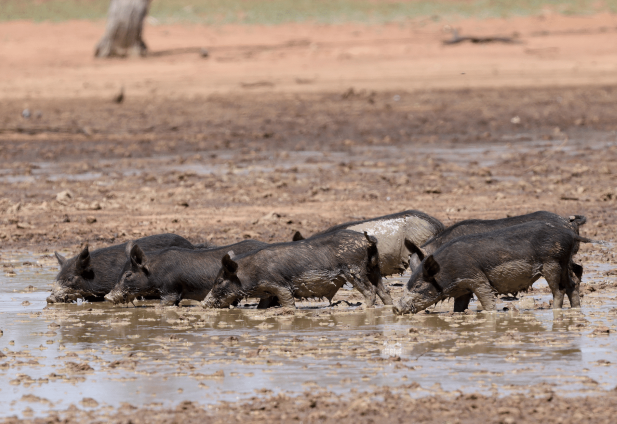Farmers can't do this alone - call for united front in feral pig control
Kristin Murdock
16 June 2023, 9:40 PM
 Industry stakeholders call for better feral pig control on public land.
Industry stakeholders call for better feral pig control on public land.Farmers in New South Wales say an explosion in feral pig numbers on public lands in the north and west of the state has resulted in massive damage to properties and livestock.
Coonamble farmer, Don Schieb previously told Western Plains app that he has noticed the increased population of feral pigs, which love the river scrub habitat from where they venture into his paddocks.
In early March he reported shooting 260 pigs in around three hours and followed up a week later with 60 more.
"They root around in the dirt in crops and shelter in it," he said. "They cause huge damage when the crops are ripe. There are so many around at the moment as the past year has seen ideal conditions for them to breed. I saw a sow with nine suckers just the other day."
While culling operations have seen more than 34,000 hoofed feral animals – including pigs, deer and goats – removed from the landscape across the state since November last year, the feral pig population remains “enormous” according to affected landholders.
Bronwyn Petrie from the NSW Farmers Conservation and Resource Management Committee said while farmers were active in trying to control pest animals and weeds on their properties, a lack of effective control on public lands was undermining their efforts.
“Farmers know that’s where the pigs are breeding because we see them coming onto our farms from public lands,” Mrs Petrie said.
NSW Farmers member Peter Mailler was still seeing them run across his front lawn at North Star, and he said they presented a huge biosecurity risk if not controlled.
“They’re doing enormous damage to property and the numbers are as bad as I’ve ever seen them,” Mr Mailler said.
“We need effective pest control management plans with the resources and commitment of all parties to tackle feral pests and weeds so we can get on top of them and stay on top of them. Farmers can’t do this individually – pigs and other pests don’t respect property boundaries, the state needs to ramp up efforts and do the job properly.”

According to the NSW Government, feral pigs were a “key threatening process” as they spread weeds and disease, hunt native animals and damage the environment. They also posed a problem for farmers as they preyed on newborn lambs, eat and destroy grain crops and pastures, and damage fences.
North Western Local Land Services (NWLLS) Senior Biosecurity Officers suggest winter is an ideal time to bait feral pigs.
"The feral pig lifecycle is very much dependent on weather conditions and seasonal conditions, " Karen Heap, Senior Biosecurity Officer of NWLLS said. "So, in the winter time they'll be chasing protein in the feed. So sometimes it's a really good time to bait depending on what location you are in. Pigs that are in a good season can start breeding at 25 kilos, so that's really, really early."
Fellow NWLLS Senior Biosecurity Officer, David Lindsay agrees the feral pests are ideally suited to the Western Plains environment and their control is challenging.
"In a really good year, there's a chance a pig could possibly have two litters and your numbers are going to breed up really quickly. So you need to be working on that and be ready to try and take advantage of any environmental factors that will help you get a good control on your pigs," he said.

IMAGE: NSW Environment & Heritage
"During the winter the frosts will tend to knock a lot of the protein out of those feed supplies and the pigs can be traveling around a little bit more because they’re not so much tied to the water. But if you can find the right pophole where they're walking through, get some grain out there, they're going to get to it really quickly and easily. And control can be sometimes the best during the winter months."
But, as NSW Farmers reports, landholders cannot tackle this massive issue alone and a focus on control in public land needs to be addressed by government.
Mrs Petrie said NSW Farmers had called for a commitment from both sides of politics to tackle the issue, by establishing an independent Natural Resource Regulator to coordinate and enforce management of public lands including National Parks (which take up 10 per cent of the state’s total area) and other Crown lands, a commitment to ongoing funding and resourcing for National Parks management, and sustainable funding to Local Land Services for pests and weeds management to build long-term resourcing certainty.
“The agencies and organisations are there, the rules are there, there just need to be resources and enforcement,” Mrs Petrie said. “Regardless of who owns a piece of land, everyone has a responsibility to do their part in keeping pests and weeds under control. We can see huge problems on the horizon if we don’t do this job properly."




